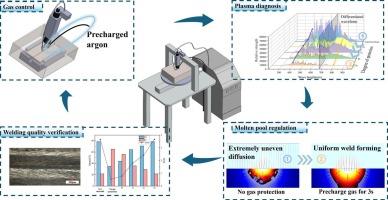激光焊接质量在线控制与监测系统的设计与机理研究
IF 7.9
2区 材料科学
Q1 MATERIALS SCIENCE, MULTIDISCIPLINARY
引用次数: 0
摘要
在钛合金激光焊接中,选用合适的保护气体是保证焊接质量的关键。通过改变保护气体预充时间,优化焊接区保护环境。进行了系统的调查,以评估这些调整对焊缝形成质量的影响。通过结合焊缝宏观形貌分析、等离子体光谱分析和微观组织评价等多尺度表征技术,阐明了焊接过程中发生的基本物理现象和焊接质量演变规律。此外,还开发了一种利用等离子体光谱诊断的实时监测方法。该方法可以通过对等离子体光谱特征的解释对焊接过程状态进行反向推断,从而建立与钛合金氧化行为的联系,促进对熔池流体动力学扰动因素的综合分析。此外,建立了基于热力学原理的数值模型来模拟熔池的动态演变,为保护气体状态影响熔池流体行为和热稳定性的机制提供了定量解释。本文章由计算机程序翻译,如有差异,请以英文原文为准。

Design and mechanism research of online control and monitoring system for laser welding quality
The utilization of appropriate protective gas is essential for achieving superior quality in the laser welding of titanium alloys. This research focuses on optimizing the protective environment of the welding zone by varying the precharge duration of the protective gas. A systematic investigation was conducted to assess the impact of these adjustments on the quality of weld formation. By employing a combination of multi-scale characterization techniques, including macro-morphological analysis of the weld, plasma spectroscopy assessments, and microstructural evaluations, the fundamental physical phenomena occurring during the welding process and the patterns of weld quality evolution were elucidated. Additionally, a real-time monitoring approach utilizing plasma spectroscopy diagnostics was developed. This method allows for the reverse inference of the welding process state through the interpretation of plasma spectral characteristics, thereby establishing connections with the oxidation behavior of titanium alloys and facilitating a comprehensive analysis of the factors contributing to disturbances in the molten pool fluid dynamics. Furthermore, a numerical model grounded in thermodynamic principles was created to simulate the dynamic evolution of the molten pool, offering a quantitative explanation of the mechanisms by which the state of the protective gas influences the fluid behavior and thermal stability of the molten pool.
求助全文
通过发布文献求助,成功后即可免费获取论文全文。
去求助
来源期刊

Materials & Design
Engineering-Mechanical Engineering
CiteScore
14.30
自引率
7.10%
发文量
1028
审稿时长
85 days
期刊介绍:
Materials and Design is a multi-disciplinary journal that publishes original research reports, review articles, and express communications. The journal focuses on studying the structure and properties of inorganic and organic materials, advancements in synthesis, processing, characterization, and testing, the design of materials and engineering systems, and their applications in technology. It aims to bring together various aspects of materials science, engineering, physics, and chemistry.
The journal explores themes ranging from materials to design and aims to reveal the connections between natural and artificial materials, as well as experiment and modeling. Manuscripts submitted to Materials and Design should contain elements of discovery and surprise, as they often contribute new insights into the architecture and function of matter.
 求助内容:
求助内容: 应助结果提醒方式:
应助结果提醒方式:


